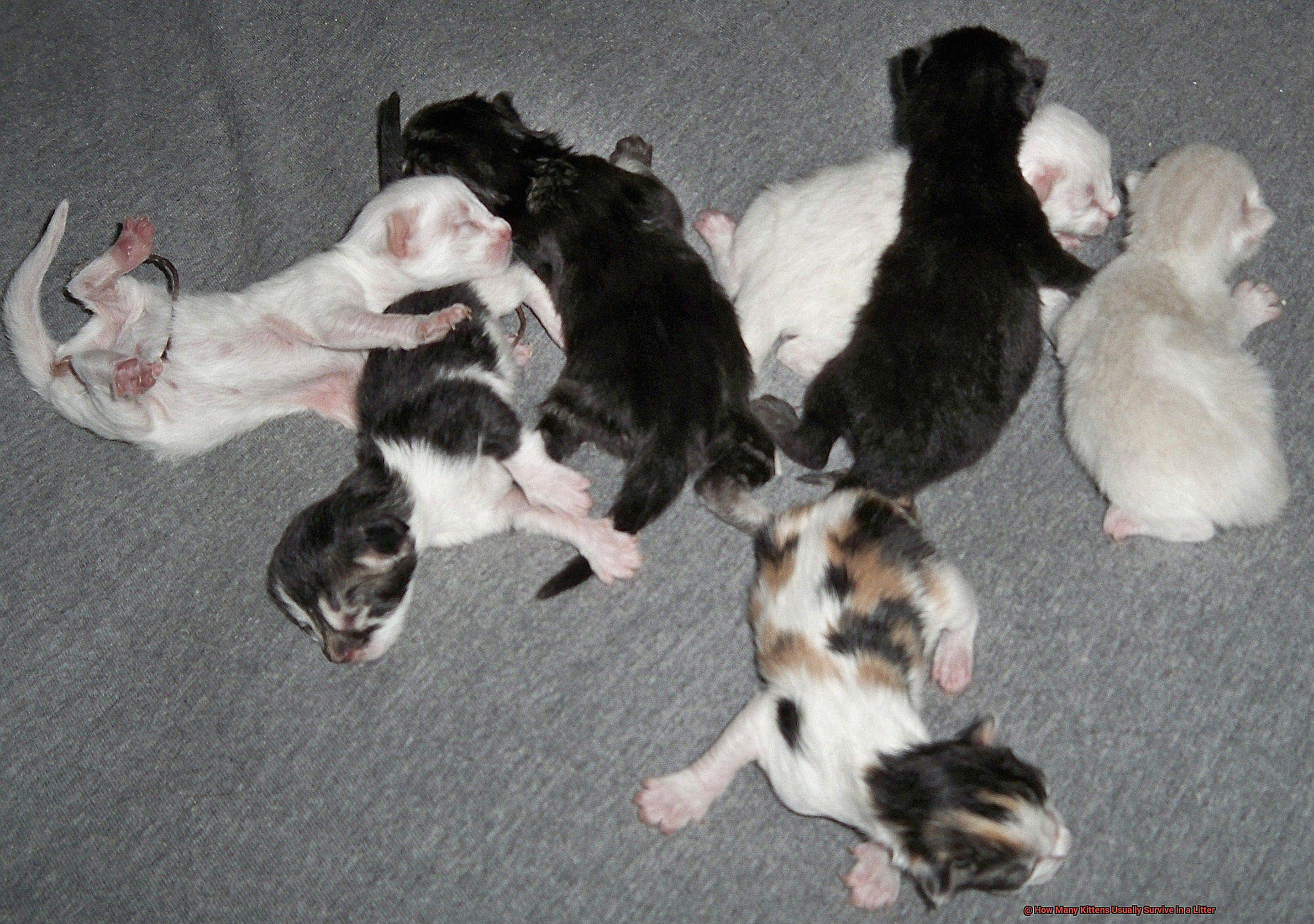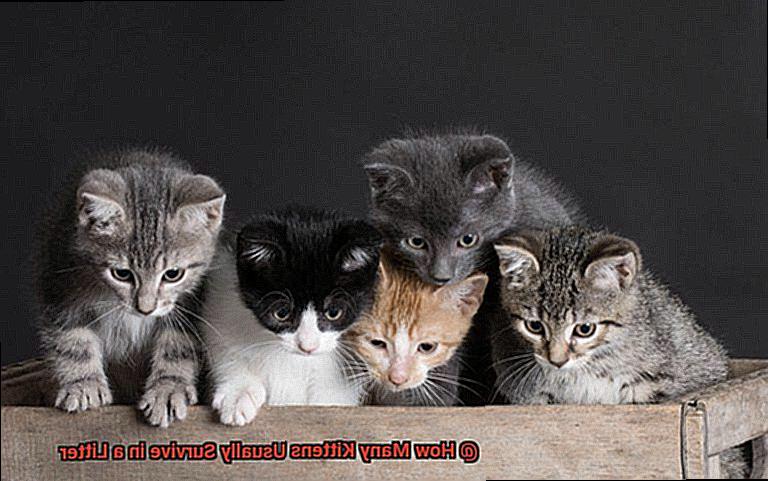If you’re a cat lover or considering getting a kitten, you may be wondering how many kittens typically survive in a litter. As someone who’s spent years working with cats, I’m here to give you the inside scoop.
Believe it or not, the number of kittens in a litter can vary depending on the breed of the mother cat. For example, Siamese cats tend to have smaller litters while Persians can have six or more little ones at once. But keep in mind that litter size doesn’t always determine how many kittens will make it to adulthood.
There are many factors that go into determining how many kittens will grow up healthy and happy. Genetics play a role, as does the health of the mother cat and the care she receives while nursing her litter. Depending on these factors, anywhere from one to nine kittens may survive.

Now that you know what to expect when it comes to litter size, let’s dive deeper into what you can do to support your mama cat and her babies for optimal survival rates.
What is the Average Litter Size for Cats?
The average litter size for cats can vary depending on several factors, including breed, age, and health of the mother cat. Typically, domestic cats have an average litter size of 3-5 kittens, but some breeds may have larger litters than others.
When it comes to age, older cats tend to have larger litters than younger ones because their reproductive systems have matured and can produce more eggs. However, this doesn’t mean that younger cats won’t have healthy litters too.

The health of the mother cat is also crucial in determining litter size. Cats that are unhealthy or malnourished may have smaller litters or experience pregnancy complications that can lead to a smaller litter size. Therefore, providing proper care and nutrition to pregnant cats is vital to ensure healthy litters.
It’s important to note that not all kittens in a litter survive. Stillborn kittens or those with congenital defects or other health problems may die shortly after birth. On average, about 85% of kittens born in a litter survive until weaning age (around 8-10 weeks).
As a responsible cat owner, it’s crucial to provide proper care and attention to your furry friend during pregnancy and birth. Regular vet check-ups and monitoring for any signs of illness or distress in the kittens are essential to ensure they receive the best care possible.
In conclusion, understanding what affects litter size can help cat owners provide optimal care for their pets. Every cat is unique and may have different needs during pregnancy and birth.
How Does the Age of the Mother Cat Affect Litter Size?
For instance, younger cats tend to have smaller litters, while older cats may have larger litters with reduced kitten survival rates.
When it comes to young cats, their reproductive system is not yet fully developed, which can limit the number of eggs released during ovulation. As a result, younger cats may only produce a few kittens in each litter. Conversely, an older cat’s reproductive system may become less efficient, making it harder to support a larger litter. This can lead to smaller or weaker kittens that may not survive.
In addition to reproductive issues, older cats may also be more prone to health problems that can affect the health of their offspring during pregnancy or birthing. Therefore, it’s crucial for cat owners to take into account their cat’s age and overall health before breeding or allowing them to mate.
It’s generally recommended that cats be at least one year old before breeding to ensure their reproductive system is fully developed and they are in good health. This way, cat owners can help ensure a healthy litter and better survival rate for their kittens.
What Role Does the Breed of the Mother Cat Play in Litter Size?
It’s true. Much like how our genes determine our physical features, the same goes for cats. Let’s dive into some fascinating research.

For instance, Siamese cats typically have smaller litters with an average of 4 kittens, while Persian cats may have litters of up to 6 kittens. This is because different breeds of cats have varying genetic makeups that can influence their reproductive abilities. However, it’s not just about breed: the size of the cat also plays a significant role. Smaller cats tend to have smaller litters, while larger cats may have larger litters. But don’t be fooled – some smaller breeds can still produce large litters.
It’s important to note that the age of the mother cat also has an impact on litter size. While younger cats usually have smaller litters, older cats may have larger ones. This is because older cats may release more eggs during their heat cycle.
But even with all these factors in mind, there is no guarantee on how many kittens will survive in a litter. Other elements such as genetics, health of the mother cat, and environmental factors also come into play. So, it’s crucial to ensure the health and well-being of our feline friends by consulting with a veterinarian for specific information on your cat’s breed and health.
What Factors Can Contribute to Kitten Mortality?
The first and foremost factor is the health of the mother cat. A healthy momma cat can provide her kittens with the necessary nutrition and care they need to thrive. On the other hand, a sick or malnourished mother cat may not be able to provide adequate milk or care, leading to higher mortality rates.
Genetics also play a role, as certain breeds are more susceptible to specific health conditions that can affect their offspring’s survival rate. For instance, Persian cats have a higher risk of respiratory problems, which can lead to higher kitten mortality.
Environmental factors also come into play. A clean and parasite-free environment is crucial for the health of the litter. The presence of parasites can cause illness and disease among the kittens. Moreover, exposure to extreme temperatures or harsh weather conditions can also put kittens at risk. Keep them warm and dry, but be careful not to cause overheating.
Human intervention can also influence kitten mortality. Improper handling or care during birth or early stages of life can lead to injury or illness, decreasing their survival rate. It’s essential to handle the kittens gently and seek veterinary attention if required.
As a responsible cat owner, it’s vital to be aware of these factors and take steps to mitigate any risks that may impact your kitten litter’s survival rate. Regular check-ups with a vet, providing proper nutrition and care for the mother cat, and maintaining a clean and safe environment are all vital steps in ensuring a healthy and thriving litter.
418YmSZlGwg” >
How Can Cat Owners Provide Proper Care for Their Feline Companions?
Whether they’re a kitten or a senior, your furry companion deserves the utmost attention and love. Here are some practical tips for ensuring your feline friend receives the proper care they need to thrive.
Firstly, proper nutrition is crucial. Your cat requires a balanced diet that meets their unique nutritional needs. You can achieve this by feeding them high-quality cat food that is specifically formulated for their age, weight, and health status. Just like humans, cats require a variety of nutrients to maintain their health.
In addition to a nutritious diet, access to clean water at all times is essential. Fresh water should be provided daily, and water bowls should be cleaned regularly to prevent bacteria growth.
Regular veterinary check-ups are also vital for your cat’s health. These check-ups can help detect potential health issues early on, leading to more effective treatment and better outcomes for your furry friend.
Finally, mental and physical stimulation is necessary for your feline companion’s well-being. Toys, scratching posts, and playtime with their owners are excellent ways to provide the necessary stimulation to keep them happy and healthy. Creating a safe and comfortable environment for your cat to live in can also promote their mental and physical health.
Also Read: How Many Kittens Usually Survive in a Litter?
Conclusion
If you’re a cat lover, you may be wondering how many kittens typically survive in a litter. While there’s no one-size-fits-all answer to this question, several factors can impact the survival rate of kittens. These factors include the breed of the mother cat, genetics, and the health of both the mother and her offspring.
To support your furry friend’s optimal survival rates, it’s essential to provide proper care and nutrition during pregnancy. Regular vet check-ups and monitoring for any signs of illness or distress in the kittens are crucial to ensure they receive the best possible care. However, it’s important to note that not all kittens in a litter survive; stillborn kittens or those with congenital defects or other health problems may die shortly after birth.
Several factors such as age, genetics, environmental conditions, and human intervention can contribute to kitten mortality. Therefore, it’s vital to be aware of these factors and take steps to mitigate any risks that may impact your kitten litter’s survival rate.
As responsible cat owners, we should prioritize our feline companions’ well-being by providing them with high-quality cat food that meets their unique nutritional needs. They should also have access to clean water at all times and regular veterinary check-ups. Additionally, mental and physical stimulation through toys and playtime with their owners can help keep them happy and healthy.
Creating a safe and comfortable environment for our cats is also essential for their overall health.







